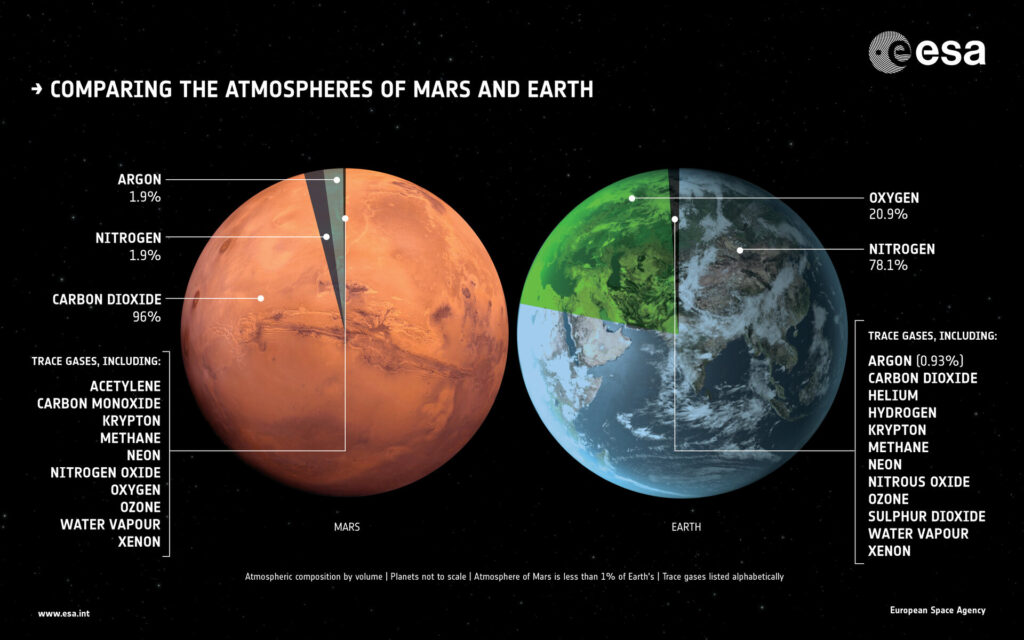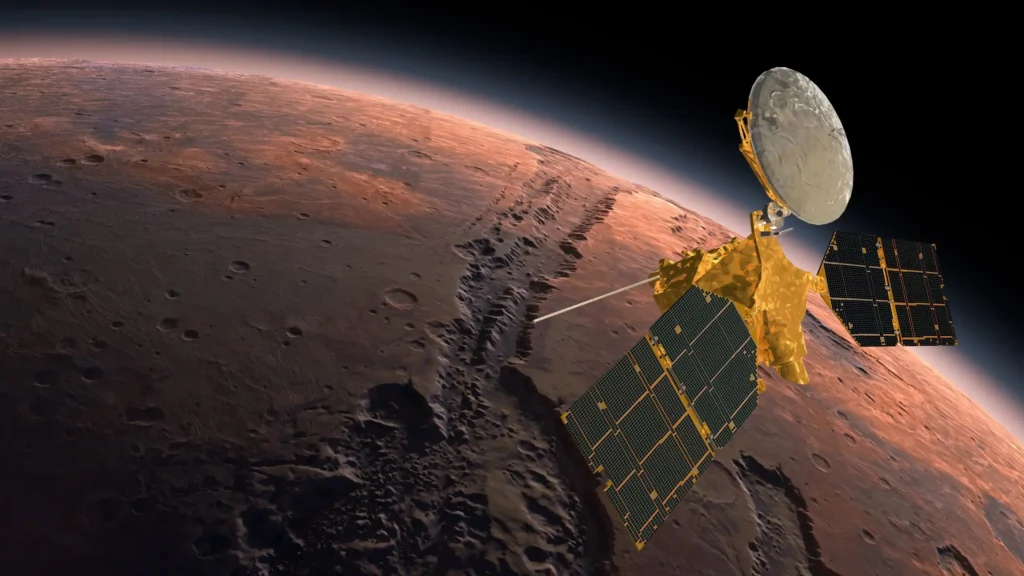EXPLORATION
TECH
Aeronautical Contributions to Mars Ascent Vehicles
- Published On
September 13th, 2024
- Author
Saal Uppal
With the first artificial satellite launched in 1957 by the Soviet Union, humanity has made great strides in developing new and advanced rockets and has since set its sights on Mars. Numerous attempts have been made to land spacecraft on the red planet, with some being successful (like the perseverance rover in 2021), and more burning up and disintegrating (like the Schiaparelli EDM in 2016) in the ruthless entry into Mars’ atmosphere. One of the more challenging parts of a Mars mission is taking off from its surface, where Mars ascent vehicles (MAVs) play a crucial role.
Mars ascent vehicles – as the name suggests - are specifically designed to launch from the Martian surface and reach orbit. Unlike rockets launched from Earth, MAVs must be built with the unique conditions of Mars, including its lower gravity, thin atmosphere, and extreme temperatures being kept in mind. These vehicles are critical for various missions, such as returning samples to Earth, supporting human exploration, and establishing sustainable habitats.
Challenges
Mars' atmosphere is about 1% the density of Earth's, which presents a significant challenge for MAVs. The thin atmosphere makes it difficult to generate aerodynamic lift and requires more efficient propulsion systems to achieve the necessary thrust. Unlike Earth, where rockets can rely on aerodynamics to steer itself while in the atmosphere, MAVs need to rely heavily upon the thrust produced by engines (a process known as thrust vectoring or gimbaling) to maintain an optimum ascent path and stay on course.
In addition to its incredibly thin atmosphere, Mars has approximately 38% of Earth's gravity. While this may sound like a good thing, it still poses a challenge for MAV design. Engineers must balance the vehicle's weight with the thrust required to reach orbit. The lower gravity allows for some design flexibility, but it also necessitates precise calculations that must be done keeping in mind Mars’ dissimilarities to Earth to ensure the MAVs can achieve the necessary velocity and trajectory to exit the atmosphere.

Mars is about half the size of Earth by diameter and has a much thinner atmosphere, with an atmospheric volume less than 1% of Earth’s. (Photo Credit: The European Space Agency)
Not only that, because of a lack of a dense atmosphere, Mars experiences extreme temperatures, ranging from about -125°C (-195°F) at the poles during winter to a maximum of 20°C (68°F) at the equator during summer. These extreme temperature variations can affect the performance of the MAV’s materials and systems. While designing, engineers must pay special attention to the materials and technology being used and design MAVs in such a way that it can survive these tough temperatures. To add to the problem, Mars’ dust is known for being pervasive, which can affect the efficiency of the landing and ascent phase of the rocket. Frequent dust-storms pose a significant threat to damaging the flight computer, sensors, or even propulsion systems. In addition to that, landing gears of the vehicle must be robust enough to handle the rugged terrain of the Martian planet, home to more than 300,000 craters peppering its red surface and the highest mountain (Olympus Mons) in our solar system.
Innovations
Advanced Propulsion Systems
To overcome the challenges of Mars' thin atmosphere, advanced propulsion systems are crucial. Several innovative technologies are being developed. Hybrid engines – as the name suggests – combine liquid fueled engines (where usually liquid oxygen and liquid hydrogen are combusted to produce thrust) with solid rocket motors to get the best of both worlds. One of the most famous examples of a hybrid engine being used is Virgin Galactic’s SpaceShip Two which uses a mix of both solid and liquid fuel to propel tourists above the Kármán line

Virgin Galactic successfully completed its first SpaceShipTwo test flight from Spaceport America about 4 years ago. (Photo Credit: Virgin)
Solid rocket boosters (SRBs) tend to generate higher thrust and are significantly simpler to construct compared to liquid fueled engines (an example of SRBs are the two white boosters flanking the sides of the orange external fuel tank on the Space Shuttle). However, they do come with their set of disadvantages; once ignited, they cannot be shut off and will keep burning until all the fuel runs out, which is a major safety concern. Unlike liquid rockets, which can adjust the flow of propellant to control the thrust, SRBs do not offer the same amount of control once launched, making them impractical to use in deep space, where very fine and minute burns may need to be executed.
However, liquid fueled engines allow for greater control as they can gimbal (change the direction of thrust) to maintain the set course, their thrust output can also be manipulated – again – giving increased control of the vessel. Moreover, many liquid fueled engines can be reignited more than once, making them very useful for long, deep space voyages, where multiple burns need to be executed. However, they are significantly more expensive and complicated to build compared to SRBs and generate relatively lower thrust which may impact the rocket’s overall efficiency where the pull of gravity is greater.
Nuclear powered engines are also a viable – yet more costly and unexplored – alternative to more conventional chemical rockets. They have been proved to produce specific impulses (unit of measurement for amount of propellant used to produce thrust) of up to 600 seconds, which may be advantageous to MAVs. Some research has been carried out by NASA in the NERVA (Nuclear Engine for Rocket Vehicle Application) program which used an engine that heated up hydrogen using a nuclear reactor to produce thrust. Even though the programme was cancelled before a flight capable engine could be built, it provided valuable insight and data into how nuclear reactors could be integrated into rocket engines. More recently, NASA’s has been exploring using nuclear energy as part of its Artemis Program that aims to land humans on the Moon for the first time since the Apollo program and later.
Lightweight Materials
Reducing the weight of MAVs is essential for efficient descent and ascent. Materials used must also be strong enough to withstand the high temperatures of entry (even with thermal shielding). As such, many mediums are being explored, each with their own pros and cons.
Lightweight composites, such as carbon-fiber-reinforced polymers, offer high strength-to-weight ratios and is known for being incredibly lightweight. While not undergoing rigorous testing, these materials are increasingly being used in aerospace applications and can be adapted for MAVs to reduce overall mass without compromising structural integrity. They also hold promise with Rocket Lab’s Neutron rocket being built out of carbon-fiber with its first flight planned in 2025.
Furthermore, alloys like stainless steel are a much cheaper alternative to the more expensive carbon fiber reinforced polymers. Many rockets use this alloy as their main structural fuselage, with the most famous being SpaceX’s Starship, slated to carry humans to the Moon and then to Mars in collaboration with NASA’s Artemis program. However, stainless steel is heavier and denser which will impact the efficiency of ascent within MAVs. In summary, materials like carbon-fiber should be used in areas where weight is a crucial factor while stainless steel should be used for more robust purposes such in landing gear or axles in Mars rovers.

After a long-term contract was signed by ESA partner ArianeGroup and ETC, Pronexos worked to build carbon fibre-reinforced polymer (CFRP) pressure vessels for use onboard their Ariane 6 rocket that launched in July of this year. (Photo Credit: Pronexos)
Thermal Protection Systems
To manage the temperature extremes on Mars’ surface and during entry, MAVs require advanced thermal protection systems. Insulation materials like Aerogel, a low-density material that traps air in its structure, are essential for protecting sensitive equipment from the harsh Martian temperatures. Additionally, multi-layer insulation (MLI), consisting of protective films with insulation gaps, helps reduce radiative heat transfer and is already widely used in aerospace applications.

A color-coded breakdown of the materials in the thermal protection system (TPS) provides a clear and organized visual representation of the different components used to shield spacecraft from extreme temperatures. (Photo Credit: NASA)
Unlike materials that passively insulate equipment, systems that actively regulate temperature through heating or cooling mechanisms are also being developed. Electric heaters can be used to warm components in cold periods, or radiators to cool components in hot periods. However, such systems come with complexities in managing power supply and consumption.
Auto Systems and AI
Unlike missions closer to Earth, where spacecraft and ground control can communicate at all times with almost no delay, missions to Mars will go long durations with no contact with Earth and will experience significant communication delays the farther they get away, because of this MAVs need to operate autonomously:
In respect to navigation, advanced algorithms and AI are being used to improve guidance systems. These systems can process data in real-time to adjust during ascent, ensuring the vehicle stays on course and avoids any anomalies that may occur during the critical stages of the mission. Moreover, autonomous systems can also monitor for any irregularities within equipment and may collect preliminary data to determine the cause of the issue with accuracy. Self-diagnosis capabilities will allow MAVs to detect and address issues without human intervention, increasing reliability and mission success rate.

NASA says “By applying artificial intelligence and machine learning, satellites control these systems seamlessly, making real-time decisions without awaiting instruction.” (Photo Credit: Mindy Support)
Conclusion
Mars ascent vehicles have become hot topics within space exploration, bridging the gap between the Martian surface and space. Aeronautical contributions to MAVs encompass a wide range of challenges and innovations, from advanced propulsion systems to lightweight materials and autonomous technologies. As always, new innovations always encounter problems, failure will show its ugly head, however – like all major problems – mankind will find a way to solve them. As we advance into the next age of space exploration, overcoming these challenges with innovative solutions is key to achieving what hasn’t been done before – landing humans on the red planet. As Elon Musk said,
“If things are not failing, you are not innovating enough.”
Subscribe To Our Newsletter
Receive amazing space news and stories that are hot off the press and ready to be read by thousands of people all around the world.
